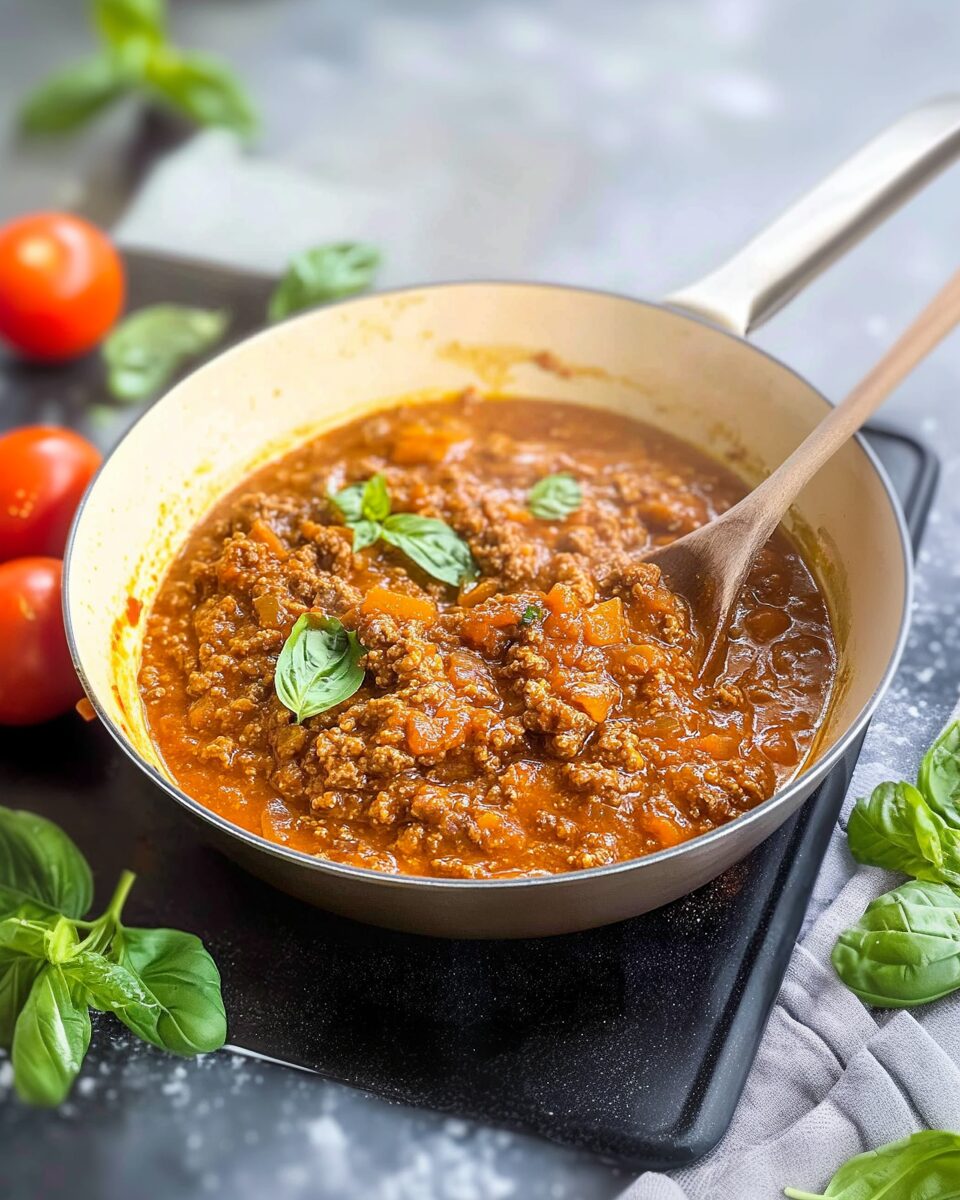There’s something incredibly comforting about a rich, hearty sauce simmering away on the stove, and beef bolognese gravy is a favorite for many. This versatile sauce pairs wonderfully with pasta, rice, or even vegetables, making for a cozy meal that feels like a hug in a bowl.
Full Recipe:
Ingredients
- 1 cup tomato sauce
- ½ cup diced bacon
- 1 cup minced meat
- ½ cup heavy cream
- ½ cup diced fresh celery
- 1 onion, chopped
- 2 garlic cloves, chopped
- 1 tablespoon fresh oregano
- 1 tablespoon fresh marjoram
- Salt and pepper, to taste
- Oil, for sautéing
Directions
- Prepare all ingredients by chopping the onions, celery, and garlic cloves, and dicing the bacon.
- In a cooking pot over medium heat, add a little oil and sauté the onions and garlic until caramelized and fragrant.
- Add the minced meat and diced bacon to the pot, breaking up the meat with a spatula. Cook for about 10 minutes until browned and no longer pink.
- Stir in the diced celery, fresh oregano, and marjoram. Cook for another 10 minutes to allow the herbs to release their aroma.
- Pour in the heavy cream and tomato sauce, stirring to combine all ingredients thoroughly.
- Reduce the heat to low and let the sauce simmer for 40 minutes, stirring occasionally. Season with salt and pepper to taste.
Nutritional Facts
Per ½ cup serving:
- Calories: 380 kcal
- Carbohydrates: 13g
- Protein: 16g
- Fat: 30g
- Saturated Fat: 12g
- Polyunsaturated Fat: 6g
- Monounsaturated Fat: 10g
- Trans Fat: 1g
- Cholesterol: 74mg
- Sodium: 781mg
- Potassium: 488mg
- Fiber: 4g
- Sugar: 5g
- Vitamin A: 823 IU
- Vitamin C: 8mg
- Calcium: 85mg
- Iron: 3mg
History of Bolognese Sauce
The origins of Bolognese sauce, or ragù alla Bolognese, date back to the 18th century in Bologna, Italy. The traditional Italian ragù was made with a mixture of meat, often including pork, veal, and beef, and it was simmered for hours to create a deeply flavorful sauce. Over time, regional variations emerged, and the recipe continued to evolve. By the early 20th century, the sauce began to resemble the version we know today—thick, rich, and made primarily with ground beef. Bolognese sauce, when translated directly, means “sauce from Bologna,” but it has since become a global culinary phenomenon.
While the term “Bolognese gravy” might sound more colloquial, it is simply a variation of the traditional ragù. The gravy component refers to the thicker, sauce-like consistency that results from long, slow cooking and the use of liquid ingredients like stock and cream. This variation adds a richness that makes it a perfect accompaniment for dishes that require a more luxurious, flavorful sauce.
The Role of Beef in Bolognese Gravy
At the heart of any great Bolognese gravy is the beef. The beef used in this recipe is typically ground, which helps the sauce reach the desired thickness and texture. The meat provides the foundation for the sauce’s savory flavor and offers a satisfying bite that complements the creamy richness of the sauce. Ground beef is often preferred because it easily absorbs the flavors of the other ingredients while releasing its own juices, which helps thicken the sauce and create a luscious, meaty gravy.
One key reason why beef works so well in Bolognese gravy is its fat content. Fat is essential in creating a gravy with depth and richness. As the beef cooks, the fat renders out, contributing to the smoothness and flavor of the sauce. Many variations of Bolognese use other meats like pork or veal, but beef is by far the most popular option in modern recipes.
The Versatility of Bolognese Gravy
Bolognese gravy is a versatile sauce that can be used in a variety of ways. Its deep, meaty flavor and velvety texture make it an excellent topping for pasta dishes, particularly those with thick, sturdy noodles like tagliatelle or pappardelle. However, it also works beautifully when paired with other ingredients, such as mashed potatoes, rice, or even roasted vegetables.
This sauce is often served as the base for lasagna, where its rich flavor can be layered between sheets of pasta and cheese. Beef Bolognese gravy can also be used as a topping for baked potatoes or as a filling for savory pies. Its rich taste pairs wonderfully with dishes that have a mild base, allowing the sauce to shine and elevate the entire meal. For those seeking an extra indulgent experience, Bolognese gravy can be stirred into risotto or even used to top polenta, turning a simple dish into something luxurious.
The Importance of Slow Cooking
One of the defining features of Beef Bolognese gravy is its long cooking time. The key to achieving the perfect Bolognese gravy lies in patience. This sauce benefits from a slow simmer, which allows the flavors to develop and meld together. Cooking the sauce for an extended period of time gives the beef a chance to release its natural flavors, while the vegetables soften and break down, creating a smooth, cohesive texture. The tomatoes, herbs, and other ingredients also have time to infuse the gravy with their distinct flavors.
Simmering the sauce slowly allows the natural sugars in the tomatoes to caramelize, intensifying their flavor and creating a subtle sweetness that balances out the savory notes of the beef. This long cooking process helps the sauce achieve a deep, rich color and complex flavor profile that can’t be rushed. While it may take time, the result is well worth the wait, as the sauce transforms into something much greater than the sum of its parts.
Herbs and Seasonings
The herbs and seasonings used in Beef Bolognese gravy play a crucial role in defining its flavor. Fresh oregano, marjoram, thyme, and basil are often incorporated to add aromatic depth and complexity to the sauce. These herbs are common in Italian cooking, and their natural flavors complement the richness of the beef, helping to balance the sauce’s richness with a fresh, earthy taste.
Garlic and onions are also key flavor components in Bolognese gravy. They are typically sautéed at the beginning of the cooking process, releasing their savory, sweet, and aromatic flavors into the sauce. The combination of garlic and onions adds depth and a savory foundation that is essential to the flavor profile of this dish. Some recipes also include carrots or celery for additional flavor and texture.
For those who enjoy a bit of heat, a pinch of red pepper flakes can add a subtle kick without overpowering the dish. Likewise, a splash of red wine or a bit of balsamic vinegar can be used to add acidity and depth, balancing out the richness of the sauce. These small adjustments can be made depending on personal preference, making Beef Bolognese gravy a highly customizable dish.
Pairing Beef Bolognese Gravy with Different Dishes
Beef Bolognese gravy is traditionally paired with pasta, but its versatility allows it to be paired with many other dishes. When it comes to pasta, wide, flat noodles like fettuccine, pappardelle, and tagliatelle are ideal for holding up to the thick, meaty sauce. The long strands of these pastas can be generously coated with the gravy, ensuring each bite is satisfying and flavorful.
For a different take, consider pairing Beef Bolognese gravy with a side of creamy mashed potatoes. The sauce can be ladled over the potatoes, creating a hearty, comforting meal that is perfect for colder weather. Alternatively, rice makes for an excellent accompaniment, soaking up the gravy and adding texture to the dish. If you prefer something lighter, consider pairing it with roasted vegetables or a crisp green salad to balance the richness of the sauce.
Conclusion
Beef Bolognese gravy is more than just a sauce; it is a comforting and versatile dish that brings people together. With its rich, savory flavor and velvety texture, it elevates any meal and can be adapted to suit a variety of tastes. Whether enjoyed over pasta, rice, or vegetables, Beef Bolognese gravy adds a touch of indulgence to any dining experience.






